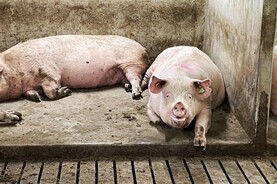Many calls have been made for a ban on horse slaughter in Ireland since the RTÉ Investigates programme revealed appalling treatment of horses in the lairage of Shannonside Foods.
The slaughter plant has been shut down, with Minster for Agriculture Charlie McConalogue confirming on Sunday that no animals have entered the food chain from the plant for the past three weeks and all carcases that were presented for slaughter last week are detained.
With investigations underway in Ireland and across Europe as a result of food fraud alleged in the programme, it may be some time before any horses are slaughtered in this country again.
That’s not necessarily a good thing.
Without a licensed slaughter outlet for horses in this country, two things are inevitable.
Some low value horses who reach the end of their active breeding or sporting lives will be simply abandoned by their owners instead of being humanely put down.
We saw this already when, in the wake of the Celtic Tiger, all types of horses were abandoned on waste ground, in forestry and urban settings.
Some higher value horses will be exported, ostensibly to be used for sport or breeding, but in reality being transported to another country hundreds of miles away for slaughter.
Neither one of these outcomes – abandonment or slaughter abroad – is a better welfare outcome than being slaughtered within this State in accordance with the rules and regulations.
Scant regard
It is clear from the RTÉ footage that there was little regard for even the most basic animal handling procedures in the lairage at Shannonside.
The facilities, in terms of floor surfaces, gates, pens and crush access, did nothing to minimise the risk of injury or stress to the horses. The staff behaviour towards the horses in the footage has been roundly and rightly condemned.
The knee-jerk reaction to the Shannonside revelations would be to permanently shut down all horse slaughter in Ireland. Instead, what’s needed is a well-run lairage and abbatoir that adheres to all rules and regulations.
Some 13,000 foals (approximately 8,000 thoroughbred and 5,000 sport horses) were born last year, and all of them will reach the end of their lives at some point, whether through injury or old age.
At this point, their owner has a decision to make. Horses are large animals and under Irish law, cannot be buried at home or on any land without a permit from the Department of Agriculture.
Pet horses are not the same as pet dogs or goldfish that can be buried in the garden.
Costs
For some owners, the decision may be an economic one.
Horses can be put down by a vet or a knackery operator, and the carcase must be then disposed of through the same fallen animal collection system used by farmers for cattle and other livestock.
A vet’s call-out fee will cost around €65 to €75. Euthanasia with a gun by a vet will cost around €50, while euthanasia by lethal injection is around €100.
Quotes for collection and disposal of a horse carcase range from €150 to €220 from licensed animal collectors.
All told, having a horse put down at home comes with a price tag of between €265 and €385.
However, where a horse is eligible for the food chain and has what’s known as a “clean passport” free from any prohibited medications or other restrictions, the owner has the option to sell the horse for slaughter.
Typically a well-fleshed adult horse weighing around 600kg would sell for €500 to €700 for slaughter.
Difference
Taking everything into account, there could be a difference of up to €1,100 between having a slaughter-eligible horse put down at home or sent to the factory.
Where a horse is not treated as a family pet, many owners choose to take the factory route.
Regardless of their motivation, economic or otherwise, horse owners expect that the slaughter process will follow all animal welfare legislation.
When the Irish and European authorities have concluded their investigations, the best outcome would be that Irish horse owners have the option to choose a best-in-class, humane and well-supervised slaughter outlet.






 This is a subscriber-only article
This is a subscriber-only article









SHARING OPTIONS: